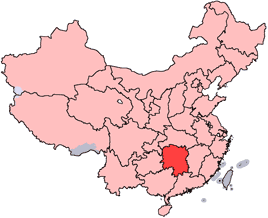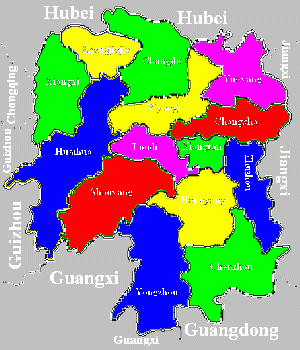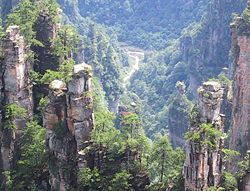Hunan
| æ¹åç Húnán ShÄng | |
| Abbreviations: æ¹Â (Pinyin: XiÄng) | |

| |
| Origin of name | æ¹ hú - lake å nán - south "south of Lake Dongting" |
| Administration type | Province |
| Capital (and largest city) |
Changsha |
| CPC Ctte Secretary | Zhou Qiang |
| Governor | Xu Shousheng |
| Area | 211800 km² (10th) |
| Population (2010) Â - Density |
65,683,722 (7th) 316/km² (13th) |
| GDP (2011) Â - per capita |
CNYÂ 1.90 trillion US$ 300 billion (10th) CNYÂ 24,719 US$ 3,652 (20th) |
| HDI (2008) | 0.781Â (medium)Â (19th) |
| Major nationalities | Han - 90% Tujia - 4% Miao - 3% Dong - 1% Yao - 1% |
| Prefecture-level | 14Â divisions |
| County-level | 122Â divisions |
| Township-levelâ | 2576Â divisions |
| ISO 3166-2 | CN-43 |
| Official website http://www.enghunan.gov.cn/ (English) | |
Hunan (Chinese: æ¹å; pinyin: Húnán) is a province of China located in the middle reaches of the Yangtze River. Its position south of Lake Dongting provides it with its name, Hunan, which means "south of the lake." Hunan is also sometimes referred to as Xiang, after the Xiang River which runs through the province.
Hunan borders Hubei to the north, Jiangxi to the east, Guangdong to the south, Guangxi to the southwest, Guizhou to the west, and Chongqing to the northwest. The capital city of the province is Changsha.
History
Hunan entered the written history of China around 350 B.C.E., when it became part of the State of Chu under the kings of the Zhou dynasty. Until that point, Hunan was a land of primeval forests occupied by the ancestors of the modern Miao, Tujia, Dong and Yao peoples. Starting at this time and for hundreds of years thereafter, it was a magnet for migration of Han Chinese from the north, who cleared most of the forests and began farming rice in the valleys and plains. To this day, many of the small villages in Hunan are named after the Han families who originally settled there, and the strong Han presence can be clearly seen in the current demographic make-up of the province. Migration from the north was especially prevalent during the Eastern Jin Dynasty and the Southern and Northern Dynasties Period, when nomadic invaders overran the north.
During the Five Dynasties and Ten Kingdoms Period, Hunan was home to its own independent regime, Ma Chu. Up until the Qing dynasty, Hunan, together with Hubei, was considered part of the province of Huguang. Hunan became an important communications center due to its strategic position on the Yangtze River, and also because of the construction of the Imperial Highway between northern and southern China. In addition to its strategic location, Hunan is also an important agricultural area of China, with its land producing grain so abundantly that it has been used to feed many parts of China with its surpluses. The population continued to climb until, by the nineteenth century, Hunan was overcrowded and became prone to peasant uprisings.
The Taiping Rebellion, which began to the south in Guangxi Province in 1850, spread into Hunan and then further eastward along the Yangtze River valley. Ultimately, it was a Hunanese army under Zeng Guofan which marched to Nanjing and put down the uprising in 1864. Hunan was relatively quiet until 1910, when there were uprisings against the crumbling Qing dynasty which were followed by the Communist's Autumn Harvest Uprising of 1927 led by Hunanese native Mao Zedong. This uprising established a short-lived Hunan soviet in 1927.
The Communists sustained their presence in the region by maintaining a guerilla army in the mountains along the Hunan-Jiangxi border until 1934. After sustaining pressure from the Kuomintang (Nationalist) forces, the Communists then began the famous Long March to their bases in Shaanxi Province. After the departure of the Communists, the KMT army fought against the Japanese in the second Sino-Japanese war, defending the capital Changsha until it fell in 1944, when Japan launched Operation Ichigo to control the railroad from Wuchang to Guangzhou (Yuehan Railway). After the defeat of the Japanese in 1945, Hunan was left relatively unscathed by the Chinese civil war that followed, and in 1949 the Communists returned once more as the Nationalists retreated southward to Taiwan.
Well known as Mao Zedong's home province, Hunan supported the Cultural Revolution of 1966-1976, and was slower than most provinces in adopting the political and economic reforms implemented by Deng Xiaoping in the years that followed Mao's death in 1976. Several prominent Chinese political figures are Hunanese, including former Chinese Premier Zhu Rongji.
Geography
Hunan Province is located on the south bank of the Yangtze River (Changjiang, é¿æ±), about half way along its length. Shanghai lies 1000 km away, Beijing 1200 km away, and Guangzhou 500 km away.
Hunan is situated between 109°-114° east longitude and 20°-30° north latitude. The province is surrounded on its east, south and west sides by mountains and hills, with the Wuling Mountains to the northwest, the Xuefeng Mountains to the west, the Nanling Mountains to the south, and the Luoxiao Mountains to the east. The province's numerous mountains and hills occupy more than 80 percent of its area and the plains comprise less than 20 percent of the total area. The center and northern parts are somewhat low and come together to form a U-shaped basin, open in the north and with Lake Dongting as its center.
Hunan has a total cultivated area of 3.92 million hectares, 18.5 percent of the provinceâs total area. Over half of the soil in the province is red or yellow earth, and nearly 20 percent of the cultivated areas are suitable for paddy planting. The province has a complete water system, fed by the Xiangjiang, the Zijiang, the Yuanjiang and the Lishui Rivers, which have a total waterway length of 2,200 km and have nearly 5,000 tributaries. These four major rivers converge together on the Yangtze River at Lake Dongting in the north of Hunan. Lake Dongting is the largest lake in the province and the second largest fresh water lake in China, with a water area of 2,691 square km. It gathers the waters of the Xiangjiang, the Zijiang, the Yuanjiang and the Lishui Rivers from the southwest, and then flows into the Yangtze River at Chenglingji.
Due to the reclamation of land for agriculture, Lake Dongting has been subdivided into many smaller lakes, though there is now a growing trend to reverse some of the reclamation, which had damaged wetland habitats surrounding the lake. Hunan's climate is subtropical, with mild winters and plenty of precipitation. January temperatures average 3 to 8 °C while July temperatures average around 27 to 30 °C. Average annual precipitation is 1200 to 1700 mm.
Major Rivers and Lakes:
- Zijiang River
- Xiang River
- Liuyan River
- Yuanjiang
- Lishui River
- Lake Dongting
Major Cities:
- Changsha
- Changde
- Dayong
- Hengyang
- Xiangtan
- Zhangjiajie
Administrative divisions
Hunan is divided into fourteen prefecture-level divisions, of which thirteen are prefecture-level cities and the remaining division an autonomous prefecture. The prefecture-level cities are:
- Changsha (Simplified Chinese: é¿æ²å¸; pinyin: ChángshÄ Shì)
- Zhangjiajie (å¼ å®¶çå¸ ZhÄngjiÄjiè Shì)
- Changde (å¸¸å¾·å¸ Chángdé Shì)
- Yiyang (çé³å¸ Yìyáng Shì)
- Yueyang (å²³é³å¸ Yuèyáng Shì)
- Zhuzhou (æ ªå·å¸ ZhÅ«zhÅu Shì)
- Xiangtan (æ¹æ½å¸ XiÄngtán Shì)
- Hengyang (è¡¡é³å¸ Héngyáng Shì)
- Chenzhou (é´å·å¸ ChénzhÅu Shì)
- Yongzhou (æ°¸å·å¸ YÇngzhÅu Shì)
- Shaoyang (éµé³å¸ Shà oyáng Shì)
- Huaihua (æåå¸ Huáihuà Shì)
- Loudi (å¨åºå¸ LóudÇ Shì)
The autonomous prefecture:
- Xiangxi Tujia and Miao Autonomous Prefecture (æ¹è¥¿å家æèæèªæ²»å· XiÄngxÄ« TÇjiÄzú Miáozú ZìzhìzhÅu)
The fourteen prefecture-level divisions of Hunan are subdivided into 122 county-level divisions (34 districts, sixteen county-level cities, 65 counties, seven autonomous counties). Those are in turn divided into 2587 township-level divisions (1098 towns, 1158 townships, 98 ethnic townships, 225 subdistricts, and eight district public offices).
See List of administrative divisions of Hunan for a complete list of county-level divisions.
Economy
Hunan is a major producer of grain in China. With only 3.2 percent of the country's arable land, the province still manages to produce 6 percent of the country's total grain, making it the fifth largest producer of the 31 provinces, municipalities and autonomous regions. In addition to this, Hunan is the largest producer of rice and ramie (especially in the Lake Dongting area), the second largest producer of tea, and the third largest producer of oranges. Some of its other well known native products include: day lily, lotus seeds, fragrant mushroom, ginger, and pepper.
Animal raising plays a significant role in the lives of farmers in Hunan, especially pig-raising, which generates a handsome amount of income, and has led to the province becoming a leading producer of pork. Other types of animals that are raised in Hunan include water buffaloes in Binhu, cattle in western Hunan and geese in Ugang county.
The Lengshuijiang area is noted for its stibnite mines, and is one of the major centers of antimony extraction in China. In general, Hunan is well known for its rich mineral resources. Specifically, it has the largest deposits of stibium and tungsten, and its deposits of rubidium, stone coal, manganese, arsenic, lead and zinc are also among the largest in China.
Hunan's nominal GDP for 2004 was 561.2 billion yuan (US$69.62 billion). In 2004, its per capita GDP was 8,423 yuan (US$1,040).
Demographics
By the end of 2002, Hunan had a total population of 66 million, consisting of 41 different ethnic groups. Its population grew 6.17 percent (3,742,700) from its 1990 levels. According to the census of 2000, 89.79 percent (57,825,400) identified themselves as Han people, 10.21 percent (6,575,300) as minority groups. The largest minority groups are the Tujia, Miao, Dong, Yao, Hui, Bai, Zhuang, and Uyghurs.
- List of Chinese ethnic groups
Education
Hunan's education system is fairly well developed compared to other provinces of China. By the end of 2002, Hunan had 60 colleges and universities, and 419,400 enrolled students. In addition, it had 16 graduate-level institutes, with 14,147 students enrolled and 24 adult colleges with an enrollment of 301,800. Along with this, the province has 113 secondary technical schools, with 223,700 students, and 4,712 middle schools, taking in 4.669 million students. Hunanâs middle school education rate is 93 percent and currently, the province has 27,243 primary schools with 5.29 million pupils. Its primary education rate is 97.64 percent. In general, secondary education has developed more rapidly than primary education in Hunan, and higher education has developed even more rapidly than secondary education. In the total population, the amount of education being received has steadily increased over the years, to the point where now the proportion of the population with at least a secondary education is substantial.
Culture
Xiang is a subdivision of spoken Chinese that originates from Hunan.
Hunan's cuisine is well known for its unique flavor. In Hunan, nearly every dish tastes hot and delicious. The people of Hunan like eating peppery foods.
Hunan's products include Xiang embroidery, one of China's four famous embroideries. With 200 years of history behind them, the chrysanthemum stone carvings of Liuyang are vivid and exquisite, and Liuyang City is known for its firecrackers, which are popular all over China.
In addition to its goods, Hunan is famous for the many important figures that have come from the province. In ancient times, Quyuan, a patriotic poet, committed suicide by throwing himself into the Miluo River. The story of his death and the search for his body started the tradition of the Dragon Boat Festival. Chairman Mao, the idol of the Chinese people and one of China's most important contemporary political figures, was born in Shaoshan. Zhu Rongji, one of the most important current leaders in the country, also comes from Hunan province.
Tourism
Hunan has many elegant landscapes and numerous historic sites. It now has over 20,000 cultural remains, including 22 national-level key protection units and 211 provincial-level key protection units.
In addition, the province has four state-class natural reserves, 22 provincial-class natural reserves, and 21 national forest parks. The total area of nature reserves is 7,260 square km, 3.43 percent of the provinceâs total.
In total, Hunan has developed 43 scenic areas. There are three national-level key scenic areas covering Mount Hengshan, Wulingyuan, Yueyang Pagoda, Dongting Lake and Shaoshan (the village where Mao Zedong was born), as well as 27 other provincialâclass scenic areas, such as Zhangjiajie, Feng Huang, and Hong Jiang. The Wulingyuan tourist area is famous for its unique natural landmarks, including limestone caves, brooks, hot springs, ancient trees and rare animals. For that reason, it been placed by the United Nations Educational, Scientific and Cultural Organization on the World Natural Heritage List. Mount Hengshan is the famous sacred mountain of Buddhism and a popular summer resort. Yueyang Pagoda is also well known both domestically and internationally for its long history, folklore, and grand architecture. Changsha, the provincial capital, is a historic and cultural city, and some of the tourist sites there include the Han Dynasty Tombs at Mawangdui, Yuelu Hill, Loving Youth Pavilion (Aiwanting), Orange Isle (Juzizhou), and the Yuelu Academy of Classical Learning.
Miscellaneous topics
Professional sports teams in Hunan include:
- Chinese Football Association Jia League
- Hunan Xiangjun
Colleges and universities
- Central South University
- Changsha University
- Hunan University
- Hunan Normal University Official website in English
- Xiangtan University
- Jishou University Jishou University website (English)
- Yuelu Academy of Classical Learning
- Xiangnan University Official website
ReferencesISBN links support NWE through referral fees
- Dunlop, Fuchsia. 2007. Revolutionary Chinese cookbook: recipes from Hunan Province. New York: W.W. Norton. ISBN 9780393062229
- Esherick, Joseph. 1976. Reform and revolution in China: the 1911 revolution in Hunan and Hubei. Michigan studies on China. Berkeley: University of California Press. ISBN 9780520030848
- Pendergast, Mary Carita. 1991. Havoc in Hunan: the Sisters of Charity in western Hunan, 1924 - 1951. Morristown, NJ: College of Saint Elizabeth Press. ISBN 9780962611926
- Perdue, Peter C. 1987. Exhausting the earth: state and peasant in Hunan, 1500-1850. Harvard East Asian monographs, 130. Cambridge, MA: Council on East Asian Studies, Harvard University. ISBN 9780674275041
- Shaffer, Lynda. 1982. Mao and the workers: the Hunan labor movement, 1920-1923. Armonk, NY: M.E. Sharpe. ISBN 9780873322041
- Shen, Congwen. 1982. Recollections of West Hunan. Beijing, China: Chinese Literature. OCLC: 9138792
- Spence, Jonathan D. 1999. Mao Zedong. New York: Viking. ISBN 9780670886692
External links
All links retrieved July 19, 2024.
| Province-level divisions administered by the People's Republic of China (PRC) | |
|---|---|
| Provinces | Anhui · Fujian · Gansu · Guangdong · Guizhou · Hainan · Hebei · Heilongjiang · Henan · Hubei · Hunan · Jiangsu · Jiangxi · Jilin · Liaoning · Qinghai · Shaanxi · Shandong · Shanxi · Sichuan · Taiwan · Yunnan · Zhejiang |
| Autonomous regions | Guangxi · Inner Mongolia · Ningxia · Tibet (Xizang) · Xinjiang |
| Municipalities | Beijing · Chongqing · Shanghai · Tianjin |
| Special administrative regions | Hong Kong · Macau |
Credits
New World Encyclopedia writers and editors rewrote and completed the Wikipedia article in accordance with New World Encyclopedia standards. This article abides by terms of the Creative Commons CC-by-sa 3.0 License (CC-by-sa), which may be used and disseminated with proper attribution. Credit is due under the terms of this license that can reference both the New World Encyclopedia contributors and the selfless volunteer contributors of the Wikimedia Foundation. To cite this article click here for a list of acceptable citing formats.The history of earlier contributions by wikipedians is accessible to researchers here:
The history of this article since it was imported to New World Encyclopedia:
Note: Some restrictions may apply to use of individual images which are separately licensed.


